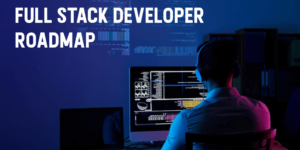
In the rapidly growing realm of technology, the role of Java full-stack developers has emerged as indispensable. These professionals serve the architects behind web applications, adeptly navigating the intricacies of front-end finesse and back-end mechanics.
Their proficiency forms a linchpin in this era where user experience is paramount and seamless server performance is non-negotiable. This article delves into a comprehensive compendium, elucidating the cardinal skills that warrant mastery for any Java full-stack developer striving to transcend mediocrity and truly shine in their multifaceted capacity.
What is Java Full Stack Developer
A Java Full Stack Developer is a software developer who possesses expertise in both front-end and back-end technologies and is capable of working on all aspects of web application development. This includes working on the user interface (UI), user experience (UX), server-side logic, databases, and everything in between.
Must-Have Java Full Stack Developer Skills
Here is the comprehensive guide to becoming a Java Full-Stack developer:
1. Proficiency in Java
Mastery of Java stands as a cornerstone skill for any Java full-stack developer. With its ubiquitous presence in software development, Java’s versatility shines as it underpins both the front-end and back-end realms. Adept Java skills empower developers to seamlessly translate creative front-end designs into functional code while constructing robust back-end structures.
This proficiency ensures fluid communication between the user interface and server and enables the implementation of intricate business logic. Consequently, a strong foundation in Java doesn’t just lay the groundwork; it erects the scaffold upon which the entire application architecture is built.
2. Understanding of Front-End Technologies
Fluency in front-end technologies constitutes a pivotal skill set for Java full-stack developers. The triumvirate of HTML, CSS, and JavaScript is the canvas upon which captivating and dynamic user interfaces are crafted. A profound comprehension of these languages empowers developers to seamlessly structure content (HTML), elegantly style elements (CSS), and infuse interactivity (JavaScript) to sculpt engaging digital landscapes.
The synergy among these technologies guarantees the creation of interfaces that adapt flawlessly across diverse devices and screen sizes, ensuring an immersive user experience. Thus, a profound grasp of front-end technologies is akin to wielding an artist’s palette, where code strokes bring life and vibrancy to virtual interactions.
3. Front-End Frameworks
Navigating the front-end development landscape is elevated by proficiency in renowned frameworks such as Angular, React, and Vue.js. These frameworks function as accelerants, expediting the design of interactive and diligent user interfaces. Angular’s comprehensive toolkit, React’s component-based architecture, and Vue.js’s progressive nature collectively empower developers to architect interfaces that seamlessly respond to user actions.
These frameworks’ abstraction streamlines complex tasks, fostering a more efficient development process. By harnessing the capabilities of these frameworks, Java full-stack developers can harness pre-designed components and implement intricate functionalities, culminating in user interfaces that not only captivate but also engage with unparalleled finesse.
4. Back-End Development
Mastery of back-end development lays the foundation for robust and functional web applications. Java full-stack developers adept in server-side programming technologies such as Spring Boot, Java EE, and Play Framework possess the prowess to craft intricate application logic. Spring Boot’s simplicity and Java EE’s extensive APIs enable the streamlined development of scalable and secure back-end systems. Similarly, the Play Framework’s reactive approach caters to high-performance applications.
Mastering the art of full-stack development demands more than technical skills; it requires the touch of a seasoned Java programmer who doesn’t just code but crafts digital solutions with precision and foresight.
This expertise empowers developers to seamlessly manage databases, handle user authentication, and facilitate data processing—essential components that drive the entire application’s functionality. Ultimately, a proficient back-end developer architects a well-oiled engine that powers the user experience.
5. RESTful APIs
A profound grasp of RESTful APIs forms a linchpin in bridging the chasm between front-end and back-end functionalities. Java full-stack developers equipped with this understanding possess the prowess to seamlessly craft and interact with APIs, facilitating smooth communication within the application’s architecture. RESTful APIs adhere to a standardized set of principles, enabling data exchange statelessly and efficiently.
Through HTTP, developers can create, retrieve, update, and delete resources, orchestrating a symphony of actions that underpin user interactions. This synergy between the front-end and back-end, produced by the mastery of RESTful APIs, ensures a harmonious user experience while safeguarding the integrity of the application’s core functionality.
6. Database Management
Navigating the intricate realm of database management is a quintessential skill for Java full-stack developers. Equipped with proficiency in SQL and NoSQL technologies like MySQL, PostgreSQL, MongoDB, and Cassandra, these developers wield the power to structure, manipulate, and extract insights from data. SQL databases offer structured and relational data storage, whereas NoSQL databases accommodate unstructured or semistructured data, accommodating modern application demands.
This expertise ensures the seamless integration of back-end functionalities with data storage, culminating in applications that perform optimally and efficiently manage the persistence and retrieval of information. A skilled database handler orchestrates the backstage, harmonizing data flow for an impeccable user experience on the front stage.
7. Version Control/Git
Proficiency in version control, notably Git, is the cornerstone of seamless collaboration and streamlined code management for Java full-stack developers. Git’s prowess lies in tracking changes, facilitating teamwork, and enabling developers to work concurrently on a codebase without conflicts. By maintaining a chronological record of modifications, developers can effortlessly revert to previous versions, ensuring code stability.
Branching and merging further enhance collaboration, as team members can work on distinct features or fixes independently and later consolidate their efforts. This proficiency not only safeguards the integrity of the codebase but also empowers developers to iterate and innovate with confidence, culminating in a harmonious symphony of code that collectively orchestrates the application’s functionality.
8. DevOps Practices
A profound comprehension of DevOps practices is pivotal for Java full-stack developers, as it unlocks the gateway to efficient software development and deployment. Mastering Continuous Integration (CI) and Continuous Deployment (CD) processes empower developers to automate the testing, integration, and deployment of code changes. This automation ensures that the codebase remains consistently functional and that new features or fixes are swiftly delivered to users.
By seamlessly merging code, running tests, and deploying updates, developers can maintain a rapid development pace while minimizing errors and bottlenecks. This synergy between development and operations not only accelerates time-to-market but also guarantees a stable and reliable application that caters to the evolving needs of users.
9. Testing
Adeptness in testing methodologies is a critical skill for Java full-stack developers, underpinning the creation of robust and error-free applications. Acquiring knowledge of testing frameworks like JUnit and tools such as Selenium empowers developers to validate the reliability and functionality of their codebase. JUnit, a widely-used testing framework, aids in automating unit tests to ensure individual components perform as intended.
On the other hand, Selenium facilitates automated testing of web applications, validating user interactions and ensuring consistent behavior across different browsers. By integrating testing practices into the development lifecycle, developers bolster the application’s stability, enhance user satisfaction, and fortify the overall quality of the software.
10. Security Awareness
A keen sense of security awareness is paramount for Java full-stack developers, serving as a sentinel against potential threats to web applications. This proficiency entails understanding common vulnerabilities such as cross-site scripting (XSS), SQL injection, and cross-site request forgery (CSRF). By grasping these potential weak points, developers can proactively implement Java best practices like input validation, data sanitization, and secure authentication mechanisms.
This fortified approach fortifies applications against malicious attacks, ensuring data integrity, user privacy, and overall system robustness. Security-conscious developers don’t just write code; they construct digital fortresses that repel threats and foster user trust in an increasingly interconnected digital landscape.
11. Containerization and Orchestration
Nurturing familiarity with containerization and orchestration is pivotal for Java full-stack developers, offering a pathway to streamlined deployment processes. Docker, which pioneered containerization, encapsulates applications and their dependencies into portable units, providing uniform behavior across various environments. Paired with Kubernetes, an orchestration tool, these containers can be efficiently managed, scaled, and automated.
Kubernetes orchestrates deployment, load balancing, and self-healing, enabling seamless scaling to accommodate varying user loads. This proficiency expedites deployment and enhances application resilience, resource optimization, and maintenance efficiency, transforming a developer’s toolkit into a dynamic symphony of efficiency and scalability.
12. Cloud Computing
Adeptness in cloud computing is a transformative skill for Java full-stack developers, opening the gateway to a dynamic and scalable application ecosystem. Mastery of cloud platforms such as AWS, Azure, or Google Cloud enables developers to host, manage, and scale applications easily. These platforms provide a wealth of services, including storage, computing power, and machine learning capabilities, all accessible on a pay-as-you-go basis.
By harnessing the cloud’s power, developers eliminate the burdens of infrastructure management, embrace cost-effectiveness through scalability, and expedite time-to-market. The cloud is not just a technological shift; it’s a paradigm shift that empowers developers to architect applications that seamlessly adapt to user demands while optimizing resource utilization.
13. Problem-Solving Skills
Aptitude in problem-solving is a hallmark of distinction for Java full-stack developers, distinguishing the adept from the exceptional. Armed with the ability to dissect intricate technical challenges, skilled developers navigate complexities with finesse. They deftly decipher issues by breaking them into manageable components, deploying logical thinking and analytical acumen to identify root causes.
Problem-solving transcends mere troubleshooting; it entails innovating creative solutions, capitalizing on existing knowledge, and sometimes embracing trial and error. This skill fosters technical prowess and cultivates adaptability in ever-evolving development landscapes. Adept problem-solvers shape applications that thrive amid adversity and emerge as solutions for users, leaving an indelible mark on the digital realm.
14. Communication Skills
Adequate communication prowess is a linchpin for Java full-stack developers, cultivating an environment of successful collaboration. Communicating ideas to group members, stakeholders, and clients ensures project coherence and alignment of development efforts. Beyond writing code, proficient developers articulate technical concepts in accessible terms, fostering shared understanding across diverse audiences.
This skill facilitates efficient requirement gathering, feedback incorporation, and conflict resolution. In an industry where collaboration drives innovation, adept communicators amplify the synergy of development teams, enhance user satisfaction through client interactions, and ultimately contribute to the seamless synthesis of vision and execution in every project.
15. Continuous Learning
Cultivating an unwavering commitment to continuous learning is the cornerstone of growth for Java full-stack developers in an ever-evolving tech landscape. The dynamic nature of technology demands that developers remain receptive to emerging trends, tools, and innovations. By embracing learning as a perpetual journey, developers fortify their adaptability and relevance.
Engaging with new languages, frameworks, and methodologies amplifies their problem-solving toolkit and enriches their expertise. In this pursuit, they remain well-equipped to respond to the evolving needs of users and stakeholders. The willingness to step beyond comfort zones, explore uncharted territories, and grow alongside technology epitomizes a developer’s dedication to coding and orchestrating technological symphonies that resonate with progress.
Java full stack developer roadmap
- Core Java Skills: Master Java fundamentals and object-oriented concepts.
- Front-End Proficiency: Learn HTML, CSS, and JavaScript for UI development.
- Front-End Frameworks: Explore React, Angular, or Vue.js for dynamic web apps.
- Back-End Development: Acquire skills in Spring Boot or Java EE.
- Database Mastery: Learn SQL (e.g., MySQL) and NoSQL (e.g., MongoDB).
- API Understanding: Grasp RESTful API design for seamless communication.
- Version Control: Become proficient in Git for collaborative coding.
- Testing Expertise: Understand testing with JUnit and Selenium.
- Security Awareness: Learn about web vulnerabilities and best practices.
- Containerization: Familiarize yourself with Docker for deployment.
- Orchestration: Explore Kubernetes for automated scaling.
- Cloud Knowledge: Gain experience in AWS, Azure, or Google Cloud.
- DevOps Practices: Embrace CI/CD workflows for efficient development.
- Problem-Solving Skills: Develop analytical thinking for debugging.
- Effective Communication: Hone collaboration and client interaction.
- Continuous Learning: Stay updated for ongoing growth.
This roadmap encapsulates the critical milestones of becoming a proficient Java full-stack developer.
Full stack Java developer salary
The salary of a full-stack Java developer can vary widely based on factors such as location, experience, skills, company size, and industry.
- Entry-Level (0-2 years of experience): The average salary for entry-level full-stack Java developers in the United States might range from $55,000 to $80,000 annually.
- Mid-Level (2-5 years of experience): Mid-level full-stack Java developers could earn an average salary ranging from $80,000 to $110,000 annually in the US.
- Senior-Level (5+ years of experience): Senior full-stack Java developers with several years of experience can earn anywhere from $100,000 to $150,000 annually in the US.
These approximate figures will change based on location (cost of living), demand, company policies, and individual negotiation skills. It’s advisable to research current salary trends in your specific region and industry for the most accurate and up-to-date information.
Conclusion
A Java full-stack developer’s expertise bridges innovation and functionality in dynamic web development. The amalgamation of front-end finesse and back-end robustness creates an ecosystem where user experiences thrive. Proficiency in Java, front-end technologies, back-end frameworks, databases, version control, DevOps practices, testing, security, containerization, cloud computing, problem-solving, communication, and continuous learning collectively forge a well-rounded skill set.
By mastering this multifaceted array of competencies, these developers become the architects of seamless, secure, and scalable applications, shaping the digital landscape with their adeptness and versatility.






